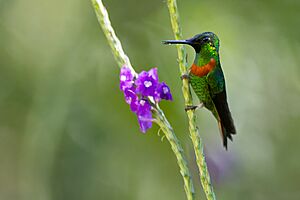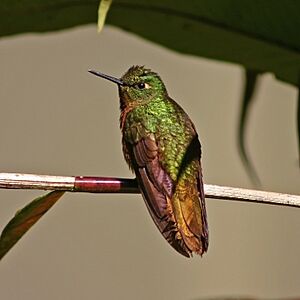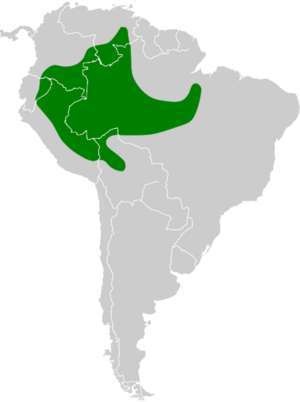Gould's jewelfront facts for kids
Quick facts for kids Gould's jewelfront |
|
|---|---|
 |
|
 |
|
| Conservation status | |
| Scientific classification | |
| Genus: |
Heliodoxa
|
| Species: |
aurescens
|
 |
|
Gould's jewelfront, also known as Gould's brilliant, is a beautiful, medium-sized hummingbird. Its scientific name is Heliodoxa aurescens. You can find this special bird in the warm, tropical parts of South America. It's not a very common bird, but it lives across a much larger area than other hummingbirds in its group, Heliodoxa. This hummingbird was named after John Gould, a famous English bird expert and artist who lived a long time ago.
Contents
Discovering the Gould's Jewelfront
The Gould's jewelfront hummingbird is usually about 11 to 12 centimeters (about 4 to 5 inches) long. It weighs around 6.2 grams, which is about the same as two pennies! Male and female Gould's jewelfronts look a little different, especially in their colors and the length of their beaks.
What Does It Look Like?
Both male and female birds have a small patch of shiny purplish-blue feathers on their forehead. This patch is not as bright on younger birds. Their beak is black or dark, and it's fairly short and straight. Their eyes are brown, and their legs are black.
The tail of the Gould's jewelfront is forked, like a "V" shape. The two feathers in the middle are bronze-green. The other tail feathers have chestnut (reddish-brown) edges and bronze-green tips. The feathers under their tail are a deep fawn color, and their wings are purplish-brown. Even though these birds live in many different places, their colors don't change much from one area to another.
Male vs. Female Birds
Male Gould's jewelfronts have bright, shiny grass-green feathers on their upper body. The sides of their neck and lower throat sparkle with a golden-green color. They also have a clear orange or reddish-brown band across their chest. Their chin, face, and upper throat are a velvety black. The rest of their underside is a shining green.
Female birds look similar to males but are a bit duller in color. Their crown (the top of their head) is green. Females also have a slightly longer beak than males. The feathers on their chin have buff-colored tips, and their throat is grayish with green spots. Females also have a buff to chestnut-colored stripe that goes from the base of their beak towards their neck.
Where Does This Hummingbird Live?
The Gould's jewelfront lives in a very large area of South America. This is quite unusual because most other hummingbirds in its group live in much smaller, more specific places, often high up in the Andes mountains.
Its Wide Home Range
You can find this hummingbird at elevations from about 250 meters (820 feet) up to 1,150 meters (3,770 feet) above sea level. Sometimes, they are even seen as high as 1,450 meters (4,750 feet)!
The northern part of their home range is in southern Venezuela. From there, it stretches south through central Ecuador and Peru. The southern edge of their range is in Bolivia. They also live in a large part of northwestern Brazil, with the eastern edge of their range in the State of Para.
How Their Range Has Grown
Over time, the area where Gould's jewelfronts live has actually expanded! When they were first discovered, people thought they only lived east of the Andes in Ecuador, Peru, and Brazil. But in 1941, they were found in Venezuela. Later, in 1984, they were seen in Bolivia, and in 2004, they were found in the Brazilian state of Mato Grosso. This shows they are slowly spreading to new areas. These birds usually stay in one place and don't migrate.
What Kind of Home Does It Like?
Gould's jewelfronts usually live in the lower parts of warm, wet tropical forests. They especially like areas near streams. You won't often see them at the very edge of the forest.
In Brazil, they have been seen in tall forests that have been affected by logging. They were even spotted feeding on flowers high up in the trees of a small forest patch surrounded by other types of land. Studies have found them in different kinds of forest, including "várzea" forest (which floods) and "terra firme" (dry land forest).
In Colombia, one study found them only in older forests that were regrowing, but never in very young regrowing forests or untouched forest undergrowth. However, a later study did see them in untouched primary forests. In Peru, they have been found in both mature floodplain forests and dry land forests.
What Does the Gould's Jewelfront Eat?
Like most hummingbirds, the Gould's jewelfront mainly eats nectar from flowers. Nectar is a sweet liquid that gives them energy. They also eat small insects, which they catch while flying in the air. This helps them get the protein they need.
Favorite Foods
We don't know a lot about their exact diet, but they have been seen feeding on plants like Bromeliads (such as Bromelia balansae) and Costus species in Brazil. Scientists have looked at many hummingbird specimens and found traces of insects in the stomachs of over half of them.
Even though they usually feed on flowers in the lower parts of the forest, they have also been seen visiting flowers high up in tall trees. In Ecuador, they sometimes visit feeding stations set up by people and can even be a bit aggressive towards other birds trying to get food there. While they are not usually territorial, it's hard to study their feeding habits because they are uncommon and not often seen.
Reproduction and Life Cycle
Not much is known about how Gould's jewelfronts reproduce. Scientists believe they might breed between June and September. The female bird lays a clutch of two eggs and takes care of them by herself.
Some studies of female birds found that their reproductive organs were well developed in February and April. However, a male bird studied in February had "small" reproductive organs, meaning it might not have been ready to breed at that time. There is still much to learn about the family life of these beautiful hummingbirds!
Conservation Status
The Gould's jewelfront is currently classified as "Least Concern" by the International Union for Conservation of Nature (IUCN). This means that while there might be some suggestions that the species is declining, it's not happening fast enough to be considered endangered right now.
Many studies show that these hummingbirds are present in their habitat, but they are not very common. Long-term studies often only find a small number of them. For example, in one three-month study in Peru, only one individual was seen in a 100-hectare (about 247-acre) study site. This means there was only about one bird per 100 hectares. Scientists continue to monitor them to make sure their populations stay healthy.
Images for kids





